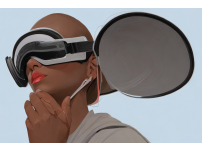의료 산업의 가상 현실(VR): 환자 관리 및 의료 교육 개선(Virtual Reality in the Healthcare I…
본문
가상 현실(VR) 기술은 환자 치료 및 의료 교육을 개선하는 새롭고 혁신적인 방법을 제공하면서 의료 산업을 빠르게 변화시키고 있습니다. VR은 의료 전문가에게 환자를 진단, 치료 및 교육하기 위한 새로운 도구를 제공할 뿐만 아니라 환자에게 보다 매력적이고 효과적인 의료 경험을 제공할 수 있는 기능을 갖추고 있습니다.
의료 산업에서 VR이 사용되는 주요 방법 중 하나는 환자 관리를 개선하는 것입니다. VR은 의사와 간호사가 실제 환자를 치료하기 전에 기술을 연습하고 개선할 수 있도록 의료 절차를 시뮬레이션하는 데 사용될 수 있습니다. 또한 VR은 환자에게 의료 시설 및 장비에 대한 가상 투어를 제공하여 불안을 줄이고 환자 만족도를 높이는 데 도움이 될 수 있습니다.
VR은 또한 학생들에게 더 몰입적이고 상호작용적인 학습 경험을 제공하면서 의학 교육을 향상시키는 데 사용되고 있습니다. 예를 들어, 의대생들은 VR 시뮬레이션을 사용하여 수술 절차를 연습하여 안전하고 통제된 환경에서 실제 경험을 쌓고 기술을 개발할 수 있습니다. 이를 통해 환자의 결과를 개선하고 실제 시술 중 합병증의 위험을 줄일 수 있습니다.
한국에서, 의료 산업은 VR 기술을 채택했고, 몇몇 병원과 의과 대학들은 훈련과 교육 프로그램에 VR을 통합했습니다. 예를 들어, 몇몇 한국 병원들은 의사들이 안전하고 통제된 환경에서 경험을 쌓고 기술을 향상시킬 수 있도록 복잡한 수술 절차를 시뮬레이션하기 위해 VR을 사용했습니다. 게다가, 한국의 의과대학들은 학생들에게 더 매력적이고 상호작용적인 학습 경험을 제공하면서 미래의 의료 전문가들의 교육을 향상시키기 위해 VR을 사용하고 있습니다.
결론적으로, VR 기술은 환자 치료 및 의료 교육을 개선하는 새롭고 혁신적인 방법을 제공하면서 의료 산업을 변화시키고 있습니다. VR 기술이 계속 발전함에 따라, 우리는 의료 산업에서 훨씬 더 많은 기술 적용을 보게 될 것이며, 환자 치료의 질과 의료 전문가 교육을 더욱 향상시킬 것입니다.
게다가, VR 기술은 또한 환자들이 만성 상태를 관리하고 공포증을 극복하는 것을 돕기 위해 사용되고 있습니다. 예를 들어, 고소공포증이 있는 환자들은 VR 시뮬레이션을 사용하여 안전하고 통제된 환경에서 공포증을 극복할 수 있습니다. 만성 통증이 있는 환자는 VR을 사용하여 통증으로부터 주의를 돌리고 진통제에 대한 의존도를 줄일 수 있습니다.
그러나 의료 산업에서 VR 기술의 사용과 관련된 과제도 있습니다. 예를 들어, VR 하드웨어와 소프트웨어는 의료 전문가와 환자 모두가 사용할 수 있도록 신뢰할 수 있고 사용자 친화적이며 경제적이어야 합니다. 또한 환자 데이터의 개인 정보 보호와 보안에 대한 우려도 있으며, 의료 업계는 환자 데이터가 무단 액세스 및 오용으로부터 보호되도록 조치를 취해야 합니다.
이러한 과제에도 불구하고 의료 산업에서 VR의 이점은 분명하며, 이 기술은 의료 전문가와 환자 모두에게 빠르게 채택되고 있습니다. VR은 환자 관리를 개선하거나, 의료 교육을 강화하거나, 환자가 만성 질환과 공포증을 관리하는 데 도움이 되든 간에 미래의 의료에서 중요한 역할을 할 수 있는 잠재력을 가지고 있습니다.
결론적으로, VR 기술은 환자 치료 및 의료 교육을 개선하는 새롭고 혁신적인 방법을 제공하면서 의료 산업을 변화시키고 있습니다. VR의 이점은 여전히 해결해야 할 과제가 있지만, VR은 의료 산업의 기업과 개인이 탐구할 가치가 있는 기술입니다. VR이 계속 발전함에 따라, 우리는 의료 서비스가 제공되고 경험되는 방식을 더욱 변화시키면서 기술의 훨씬 더 혁신적인 사용을 보게 될 것입니다.
Virtual Reality (VR) technology is rapidly transforming the healthcare industry, offering new and innovative ways of improving patient care and medical education. VR has the ability to provide healthcare professionals with new tools for diagnosing, treating, and educating patients, as well as providing patients with a more engaging and effective healthcare experience.
One of the key ways VR is being used in the healthcare industry is to improve patient care. VR can be used to simulate medical procedures, allowing doctors and nurses to practice and refine their techniques before treating real patients. Additionally, VR can also be used to provide patients with virtual tours of medical facilities and equipment, helping to reduce anxiety and increase patient satisfaction.
VR is also being used to enhance medical education, providing students with a more immersive and interactive learning experience. For example, medical students can use VR simulations to practice surgical procedures, allowing them to gain hands-on experience and develop their skills in a safe and controlled environment. This can help to improve patient outcomes, as well as reducing the risk of complications during real-world procedures.
In Korea, the healthcare industry has embraced VR technology, with several hospitals and medical schools incorporating VR into their training and education programs. For example, several Korean hospitals have used VR to simulate complex surgical procedures, allowing doctors to gain experience and improve their skills in a safe and controlled environment. Additionally, medical schools in Korea are also using VR to enhance the education of future healthcare professionals, providing students with a more engaging and interactive learning experience.
In conclusion, VR technology is transforming the healthcare industry, offering new and innovative ways of improving patient care and medical education. As VR technology continues to evolve, it is likely that we will see even more applications of the technology in the healthcare industry, further improving the quality of patient care and the education of healthcare professionals.
Additionally, VR technology is also being used to help patients manage chronic conditions and overcome phobias. For instance, patients with a fear of heights can use VR simulations to overcome their phobia in a safe and controlled environment. Patients with chronic pain can also use VR to distract themselves from their pain and reduce their reliance on pain medication.
However, there are also challenges associated with the use of VR technology in the healthcare industry. For example, there is a need for VR hardware and software to be reliable, user-friendly, and affordable, so that it can be used by healthcare professionals and patients alike. Additionally, there are also concerns about the privacy and security of patient data, and the healthcare industry must take steps to ensure that patient data is protected from unauthorized access and misuse.
Despite these challenges, the benefits of VR in the healthcare industry are clear, and the technology is rapidly being adopted by healthcare professionals and patients alike. Whether it is improving patient care, enhancing medical education, or helping patients manage chronic conditions and phobias, VR has the potential to play a critical role in the future of healthcare.
In conclusion, VR technology is transforming the healthcare industry, offering new and innovative ways of improving patient care and medical education. While there are still challenges to be addressed, the benefits of VR make it a technology worth exploring for businesses and individuals in the healthcare industry. As VR continues to evolve, it is likely that we will see even more innovative uses of the technology, further transforming the way healthcare is delivered and experienced.














댓글목록 0